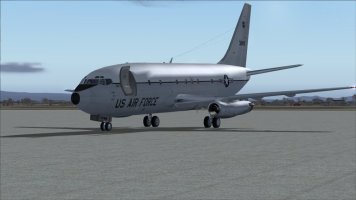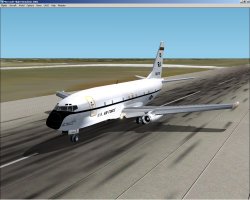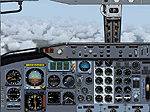Sbob
SOH-CM-2025
PART TWO.
And now, without further adieu, its time to climb down the ladder into The Black Hole of Calcutta. Its time to meet the real stars of the show. After all, if The B-52 can't get from point A to B (with a re-fueling and a bomb run along the way), what good is it?
We'll start off with the navigator, known as NAV or in the AC's case, "Hey, NAV..where ARE we?". The NAV, like the CO, is usually one of the newer members of the crew. The NAV's primary duty is keeping a running D-R (dead reckoning) track of the plane through out its sortie in the air while plotting enough nav fixes to keep the whole show on its rails. It sounds over-whelming and, at first, it is. Its up to the NAV to become a "good NAV" and a "good NAV", well, knows how to cheat. The B-52 is too big and too fast to use regular navigation tools and skills. Treat this plane like a Cessna and you will wind up behind the curve. So, what's the difference between a "good NAV" and a "great NAV"? A "good NAV" knows how to cheat. A "great NAV" knows how to cheat and make it look legit. What's the difference between a "good NAV" and a "bad NAV"? Two minutes, a NAV who gets off track by more than two minutes won't be a NAV for long. THIS is part of the experience that will make your head hurt. Luckily, we'll be using that ACS-GPS V2 gauge to fill in for most of the NAV's duties. There's a reason I'll keep harping on building up your Situational Awareness, you have to almost "feel" what this plane wants to do. The best news is, you will get there. All of a sudden, the Universe will open up and want to shake your hand. That light bulb will blink on and you'll know.
Wrapping up on our NAV, while many pilots would say that Nav Wings means "dropped wanna be pilot", the truth of the matter is that many NAVs made it out of collage with a tougher degree than their upper deck counter parts. Lots of class time and labs, lots of calculus, lots of burning the midnight oil, lots of reasons to have it effect their eye sight. Once again, the NAV is one of the junior members of the crew, usually a freshly-minted leutenant. Their seat is on the right side of the lower deck, facing forward.
Last of all for the crew dogs is the Radar Navigator, Bombardier, or RNAV. Big surprise, the RNAV started out in the seat to their right. After a couple of years of shaking hands with the Universe and learning how to cheat, the former NAV goes through some in-house squadron training and gets up graded to be The Master Of The BNS (aka Bombing and Navigation System). The RNAV gets the bigger Radar screen and the spindle-like BNS joystick. The RNAV also gets a LOT more switches to flip and is in charge of making sure all the stuff hanging on the pylons or in the bomb bay gets dropped at the precise millisecond. The RNAV also controls the Radar's output power and antenna gain and tilt.
Its a big job and the RNAV and NAV have to work well as a well-oiled and efficient team. Our typical RNAV is a captain or possibly a major.
While a crew doesn't need to be best friends, they DO need to be a family. Crew Dogs tend to be a close-knit group who will spend years working together as a team.
A new B-52 crew will start out as Non-Rated, NR-(followed by a number). Its the one-and-only goal of an NR crew to move up the ladder to being Rated, R-(followed by a number). Getting that R rating will mean training flights, usually at least three after they get to their home BW, where the crew proves they can work as a team and also get along. Being able to refuel and hit a target, on time, is the bulk of this training. The final NR training flight will also include "the I folks", an Instructor Pilot, Instructor EW, and Instructor RNAV. This flight is like "shooting for score" and the pressure is definitely ON. If our NR crew doesn't get the thumbs up from the "I folks", all of them, its back to square one. Messing up that check ride can come down to missing something trivial, the "I folks" don't mess around.
NOTE: THE FOLLOWING INFORMATION IS PUBLICALLY AVAILABLE AND NOT CONSIDERED CLASSIFIED.
Once the "I folks" have given their blessings, the final job for our intrepid NR crew is to get their targets and tankers in SAC's portion of the SIOP (Single Integrated Operation Plan). This process sounds very basic, it has to. The RNAV and AC (two man rule from here on out) will be given a set of tanker tracks and target locations. The targets are mainly somewhere in the Warsaw Pact and/or the People's Republic of China, depending on the base's location. Along with these locations will be the crew's H Hour Control Line (HHCL), a location and time after the Alert code has been given. At some point between the Alert code and prior to crossing the HHCL, the crew must expect either a Recall code or a Go code. A valid Recall code means "turn around and head for home". A valid Go code, and ONLY a valid Go code, means "cross the HHCL and proceed to your assigned targets". Anything in-between and the crew will be expected to hold behind the HHCL, for as long as possible. And, that's it.. Who knew that the end of the world could be this simple?
At this point, our (still but oh so close) NR crew gets together for flight planning and to prepare a detailed briefing on their SIOP mission. Once prepared, the crew (the whole crew) will deliver their briefing to a small audience containing the BW's Co., The general for the BW's numbered Air Force (something like 5th Air Force), and maybe a general from Offut AFB's "targeteers". This audience can, and usually does, ask ANY question related to anything in the crew's part of the SIOP, SIOP general procedures ("two man rule", "no lone zone", etc.), bomb loading procedures, DETAILLED target analysis and attack/evasion plans, flight plans, enemy capabilities (how to beat a SAM), etc., etc., etc.
If the audience gives their thumb's up, its time for a quick round of beers and a quicker check of the BW's Alert Force Roster. They did it, they are now an R rated crew. From here on out, our R crew will spend (usually) three weeks per month planning and flying training missions (figure one training flight per week) and one week per month on Alert duty. We'll get into how training flights get assigned and the perils of Alert Duty in a later post.
And now, without further adieu, its time to climb down the ladder into The Black Hole of Calcutta. Its time to meet the real stars of the show. After all, if The B-52 can't get from point A to B (with a re-fueling and a bomb run along the way), what good is it?
We'll start off with the navigator, known as NAV or in the AC's case, "Hey, NAV..where ARE we?". The NAV, like the CO, is usually one of the newer members of the crew. The NAV's primary duty is keeping a running D-R (dead reckoning) track of the plane through out its sortie in the air while plotting enough nav fixes to keep the whole show on its rails. It sounds over-whelming and, at first, it is. Its up to the NAV to become a "good NAV" and a "good NAV", well, knows how to cheat. The B-52 is too big and too fast to use regular navigation tools and skills. Treat this plane like a Cessna and you will wind up behind the curve. So, what's the difference between a "good NAV" and a "great NAV"? A "good NAV" knows how to cheat. A "great NAV" knows how to cheat and make it look legit. What's the difference between a "good NAV" and a "bad NAV"? Two minutes, a NAV who gets off track by more than two minutes won't be a NAV for long. THIS is part of the experience that will make your head hurt. Luckily, we'll be using that ACS-GPS V2 gauge to fill in for most of the NAV's duties. There's a reason I'll keep harping on building up your Situational Awareness, you have to almost "feel" what this plane wants to do. The best news is, you will get there. All of a sudden, the Universe will open up and want to shake your hand. That light bulb will blink on and you'll know.
Wrapping up on our NAV, while many pilots would say that Nav Wings means "dropped wanna be pilot", the truth of the matter is that many NAVs made it out of collage with a tougher degree than their upper deck counter parts. Lots of class time and labs, lots of calculus, lots of burning the midnight oil, lots of reasons to have it effect their eye sight. Once again, the NAV is one of the junior members of the crew, usually a freshly-minted leutenant. Their seat is on the right side of the lower deck, facing forward.
Last of all for the crew dogs is the Radar Navigator, Bombardier, or RNAV. Big surprise, the RNAV started out in the seat to their right. After a couple of years of shaking hands with the Universe and learning how to cheat, the former NAV goes through some in-house squadron training and gets up graded to be The Master Of The BNS (aka Bombing and Navigation System). The RNAV gets the bigger Radar screen and the spindle-like BNS joystick. The RNAV also gets a LOT more switches to flip and is in charge of making sure all the stuff hanging on the pylons or in the bomb bay gets dropped at the precise millisecond. The RNAV also controls the Radar's output power and antenna gain and tilt.
Its a big job and the RNAV and NAV have to work well as a well-oiled and efficient team. Our typical RNAV is a captain or possibly a major.
While a crew doesn't need to be best friends, they DO need to be a family. Crew Dogs tend to be a close-knit group who will spend years working together as a team.
A new B-52 crew will start out as Non-Rated, NR-(followed by a number). Its the one-and-only goal of an NR crew to move up the ladder to being Rated, R-(followed by a number). Getting that R rating will mean training flights, usually at least three after they get to their home BW, where the crew proves they can work as a team and also get along. Being able to refuel and hit a target, on time, is the bulk of this training. The final NR training flight will also include "the I folks", an Instructor Pilot, Instructor EW, and Instructor RNAV. This flight is like "shooting for score" and the pressure is definitely ON. If our NR crew doesn't get the thumbs up from the "I folks", all of them, its back to square one. Messing up that check ride can come down to missing something trivial, the "I folks" don't mess around.
NOTE: THE FOLLOWING INFORMATION IS PUBLICALLY AVAILABLE AND NOT CONSIDERED CLASSIFIED.
Once the "I folks" have given their blessings, the final job for our intrepid NR crew is to get their targets and tankers in SAC's portion of the SIOP (Single Integrated Operation Plan). This process sounds very basic, it has to. The RNAV and AC (two man rule from here on out) will be given a set of tanker tracks and target locations. The targets are mainly somewhere in the Warsaw Pact and/or the People's Republic of China, depending on the base's location. Along with these locations will be the crew's H Hour Control Line (HHCL), a location and time after the Alert code has been given. At some point between the Alert code and prior to crossing the HHCL, the crew must expect either a Recall code or a Go code. A valid Recall code means "turn around and head for home". A valid Go code, and ONLY a valid Go code, means "cross the HHCL and proceed to your assigned targets". Anything in-between and the crew will be expected to hold behind the HHCL, for as long as possible. And, that's it.. Who knew that the end of the world could be this simple?
At this point, our (still but oh so close) NR crew gets together for flight planning and to prepare a detailed briefing on their SIOP mission. Once prepared, the crew (the whole crew) will deliver their briefing to a small audience containing the BW's Co., The general for the BW's numbered Air Force (something like 5th Air Force), and maybe a general from Offut AFB's "targeteers". This audience can, and usually does, ask ANY question related to anything in the crew's part of the SIOP, SIOP general procedures ("two man rule", "no lone zone", etc.), bomb loading procedures, DETAILLED target analysis and attack/evasion plans, flight plans, enemy capabilities (how to beat a SAM), etc., etc., etc.
If the audience gives their thumb's up, its time for a quick round of beers and a quicker check of the BW's Alert Force Roster. They did it, they are now an R rated crew. From here on out, our R crew will spend (usually) three weeks per month planning and flying training missions (figure one training flight per week) and one week per month on Alert duty. We'll get into how training flights get assigned and the perils of Alert Duty in a later post.
Last edited:



 This took about two hours of flight time. It was like FS(2002) was saying "Thanks for sticking with it, here's some eye candy."
This took about two hours of flight time. It was like FS(2002) was saying "Thanks for sticking with it, here's some eye candy."








